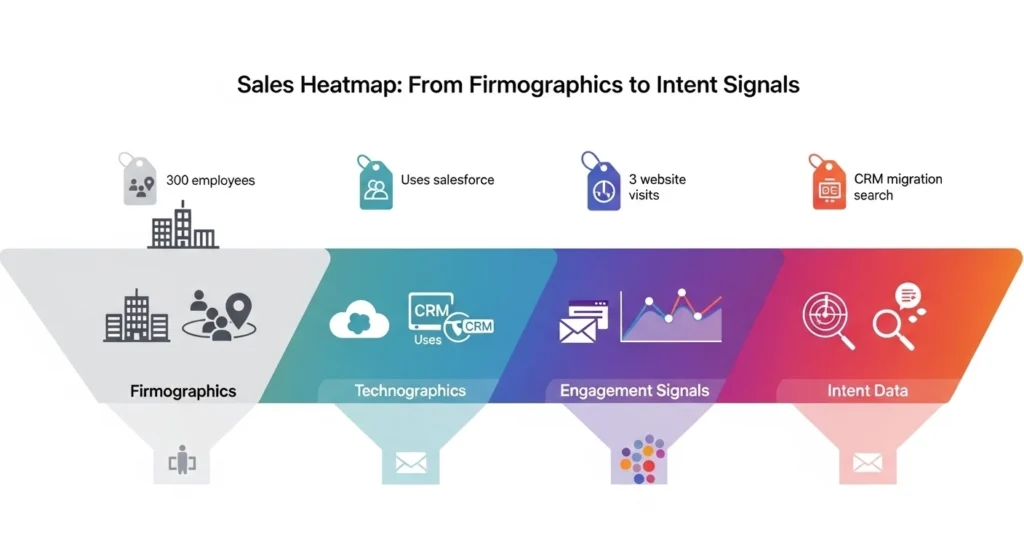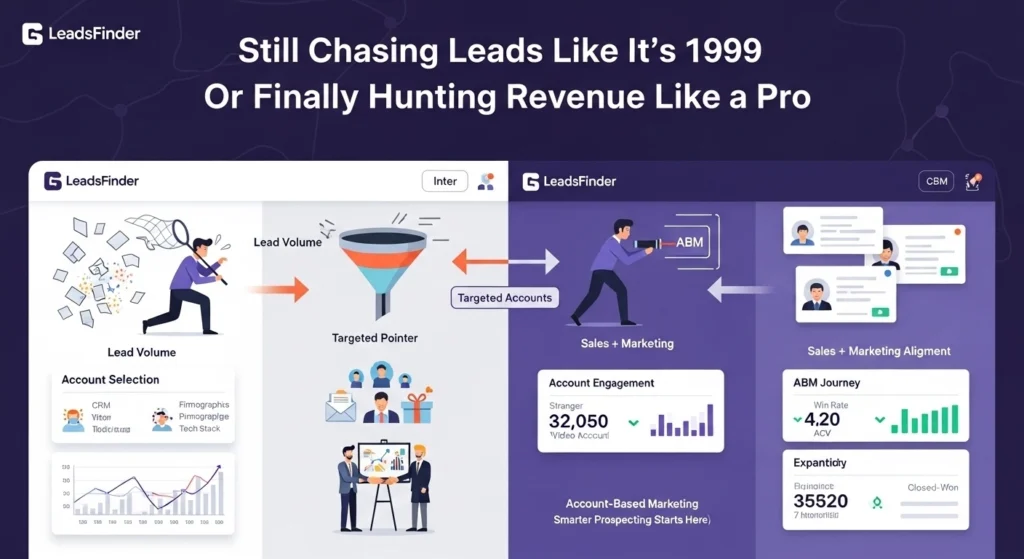Table of Contents
Still Chasing Leads Like It’s 1999—Or Finally Hunting Revenue Like a Pro?
Let’s not sugarcoat this. If you’re still using the same lead-gen playbook from a decade ago, it probably feels like throwing glitter into a windstorm and praying it lands somewhere useful.
We’ve lived through it too. You pour time, money, and team energy into pulling in loads of leads… but the close rate? It barely budges. Your CRM’s jam-packed with contacts, but the sales team is yawning. It’s frustrating. Burnout starts creeping in. And you begin to wonder—what are we doing wrong?
That’s where we hit pause. At LeadsFinder.tools, we realized we weren’t actually chasing revenue—we were just collecting email addresses and hoping for the best. So, we flipped the approach entirely.
We ditched the spray-and-pray. Instead of casting the widest net possible, we started acting more like sharpshooters—zeroing in on high-value accounts and giving them the attention they deserved.
This is Account-Based Marketing (ABM) in action. And it’s a game-changer. Not theory. Not buzzwords. Real tactics. Real results.
Why ABM Isn’t Just Another Trend—It’s the Smartest Move in B2B Right Now
Here’s the honest truth: ABM works because it respects your time—and your buyer’s.
We stacked our traditional wide-net efforts against a focused ABM campaign. The difference was night and day. It wasn’t just better—it was obvious. Our old strategy felt like yelling into the void. ABM felt like having an actual conversation with the right person, at the right time.
Smaller lead lists, deeper relationships, faster closes, and bigger contracts. That’s not hype. That’s what happens when you stop trying to “nurture” everyone and start focusing on the folks who are actually ready to buy.
From Leads to Accounts—And Why That Changes Everything
Here’s the mental shift: ABM isn’t just another marketing technique. It’s a way to rewire how sales and marketing work together. Not side-by-side. As one team.
We’ve seen this firsthand. When both sides stop operating in silos and start working from the same playbook—aligned goals, shared insights, unified strategy—the results speak for themselves. No more blaming. No more passing cold leads across the table. Just results.

Building ABM from the Ground Up (No Guesswork—This Is Our Actual Playbook)
Here’s how we do it. Step-by-step. No fluff. Just what’s worked for us and our clients.
Step 1: Get Ruthlessly Clear on Who You’re Selling To (Build Your ICP + TAL)
Don’t lift a finger until you really know who your ideal customer is. Not just “anyone in fintech” or “companies with 100+ employees.” That’s vague. And vague doesn’t close deals.
Define Your ICP Like a Pro
Start with your best customers. What do they have in common?
- What industry are they in?
- How many people do they employ?
- What tools do they use?
- What are their biggest operational headaches?
We use LeadsFinder.tools to pull data on firmographics, technographics, and real buyer pain points. It lets us move past surface-level info and build a full picture.
Lesson Learned: We once spent months targeting an industry we were sure was ideal. But the data said otherwise. Once we analyzed actual performance and layered in intent signals, we uncovered a different vertical with 3x the conversion rate. It completely changed our trajectory.
Build a Realistic Target Account List (TAL)
Now, based on your ICP, handpick your dream accounts. But be honest. Don’t create a “maybe someday” wish list. Create a list of companies you actually believe you can help—and win.
- For one-to-one ABM, that might be just 5 or 10.
- For one-to-few, think 20–50 grouped by vertical or challenge.
- For one-to-many, go bigger—but automate intelligently.
Pro Move: Use LeadsFinder.tools to filter accounts by recent funding, employee count, tech stack, and even hiring signals. That way, your list isn’t just big—it’s smart.
Step 2: Know Each Account Like You’ve Been in Their Shoes
Once you’ve got your list, it’s time to go deep—not wide. Research each account like you’re prepping for a job interview.
Do Your Homework (Beyond Just Clicking “About Us”)
Dig into:
- News and press releases
- Key decision-makers on LinkedIn
- Company blog content
- Industry shifts that could affect them
Quoting Ardath Albee: “You can’t create relevant content if you don’t understand the relevant context.” Spot on
Intent Data = Instant Advantage
Here’s what changes the game: Knowing who is actively researching solutions like yours.
If someone from your target list suddenly starts reading up on CRM migrations, cloud security, or outbound sales tools—that’s a giant, flashing arrow pointing you toward them. Reach out while they’re warm.
Imagine a graphic here with layers of research—firmographics, technographics, behavioral triggers, then intent data at the core.
Step 3: Create Content That Feels Like It Was Made Just for Them
Generic messaging is a non-starter in ABM. If you’re still sending out “Hi [First Name], check out our whitepaper,” you’re behind.
Hyper-Personalized = High-Converting
Build content for them. Not for everyone.
Example: “How [Your Company] Helped [Their Competitor] Boost Revenue by 30%” beats “10 Ways to Scale Sales” every time.
Multi-Channel = Multi-Touch (Not Spammy, Just Smart)
Use a coordinated mix of:
- Email: Not mass sends. We’re talking short, value-packed, customized notes.
- Targeted Ads: Speak directly to the DMU, right in their LinkedIn feed.
- Website Personalization: Make your homepage feel like it knows who’s visiting
- Direct Mail: A thoughtful gift or handwritten note still cuts through the noise
- Invite-Only Events: Private executive roundtables work way better than booths at trade shows.
- LinkedIn Engagement: Not just likes—real, helpful comments that build rapport.
Step 4: Sales + Marketing = One Team (Smarketing in Real Life)
This is where good campaigns either shine or stall out. You can’t do ABM with two teams pulling in opposite directions.
Share Everything—Goals, Tools, Wins, Losses
Align KPIs like:
- Revenue contribution
- Pipeline movement
- Average deal size
- Engagement by account
Weekly Syncs > Occasional Debriefs
Marketing gives sales intel. Sales gives marketing context. Rinse and repeat.
Your Tools Must Talk
Your CRM (Salesforce, HubSpot, whatever you use) needs to integrate tightly with your ABM and marketing tools. Otherwise, you’ll miss engagement signals—and leads will fall through the cracks.
Watch Out: Don’t push accounts to sales too early. Warm them up fully. Sales hates cold handoffs. And it hurts your credibility.
Step 5: Measure the Right Stuff—and Tweak Relentlessly
This isn’t a “set it and forget it” play. You’ll need to track, test, and keep adjusting.
Metrics We Obsess Over
- Engagement: Are they opening emails, clicking ads, reading content?
- Pipeline Velocity: Are they moving faster than non-ABM leads?
- Win Rates: Are ABM accounts closing more consistently?
- Deal Size: Are these bigger wins?
- Lifetime Value: Are they sticking around longer? Expanding?
- CPA: Are you spending efficiently per account?
Show Your Team the Dashboard
Give sales and marketing a shared view. See what’s working and what’s falling flat. Then tweak. Rinse. Repeat.
Lessons We Learned the Hard Way (So You Don’t Have To)
- Don’t Wing It: If you don’t deeply understand your target account, nothing else matters.
- Lead With Solutions, Not Features: Talk about their pain points—not your tool’s specs.
- Crawl First, Then Walk: Don’t start with 500 accounts. Start small. Master your approach. Then scale.
- ABM = Iteration: Nothing stays static. Tweak campaigns based on real behavior.
- Post-Sale = Part of the Strategy: Don’t stop after the win. The best ABM efforts include upsell, cross-sell, and turning clients into advocates.
Final Thoughts: Stop Chasing. Start Closing.
Traditional lead gen is running out of gas. You know it. Your team feels it. And your results show it.
ABM is how you start doing more with less. More relevance. More connection. More revenue.
You don’t need to blow your budget. You just need a smarter approach. One that’s focused, intentional, and backed by data.
So what do you say? Ready to stop guessing and start closing?
FAQs
Q1: How long until ABM Marketing Strategy shows results?
Give it a few weeks for early engagement. Real revenue results often hit in 3–6 months, depending on your sales cycle. It’s not instant—but it’s powerful
Q2: Can small businesses do ABM?
100%. You don’t need a huge team. Just a sharp ICP, the right tools, and a plan. Start with one-to-few and grow from there.
Q3: What’s the core difference between ABM and traditional lead gen?
Old-school lead gen = quantity over quality. ABM = quality first, with real personalization. You don’t chase everyone. You build relationships with the right ones
.
